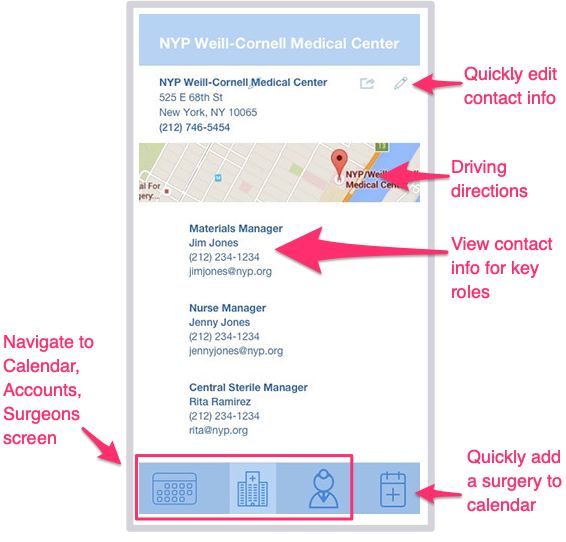Hi.
I’m Kerry.
I’m a Senior User Experience Researcher, living in New York City.

I’m Kerry.
I’m a Senior User Experience Researcher, living in New York City.
UX research and ideation for a mobile app to optimize sales opportunities by managing daily schedules for medical device sales reps in the field.
Medical device sales reps want to maximize face time with surgeons in operating rooms. Last minute changes to surgical schedules create hours of wasted time in congested, urban territories. Sales reps need real time updates for schedules in several facilities at the same time. They can make better choices about which surgeries to attend and optimize sales opportunities.
Health care facilities allow only sanctioned external communication from the internal system
Scheduling concerns for medical sales reps are often a very low priority for busy surgical facility staff and administrators. There is no compelling reason to facilitate the sales process for one sales rep over another.
The prospect of HIPAA violation prevents surgical scheduling staff from risking communication outside existing system.
Ancillary finding: surgeons often depend on medical reps to guide them through the use of new orthopedic techniques and products during surgery. They get angry when rep isn’t present to facilitate the use of a new product, jeopardizing customer service.
Methodology: Field Studies and 1:1 Interviews, Collaborative Design
Step 1. Research
1:1 Interviews
I conducted interviews and ride-alongs with sales reps to learn about the challenge, explore current experience, and understand pain points

Field Studies
I accompanied sales reps to learn how sales teams communicate and optimize schedules. I wanted to understand how team members pivot quickly when and how surgery schedules change.
I also observed multiple interactions between staff, sales, and surgeons, conducting multiple 1:1 interviews with each to understand their limitations and experience.
Step 2. Sketching & Collaborative Design


Wireframes (1)




Wireframes (second iteration)

Step 4. Usability Testing

Next Step

Project discontinued; low likelihood of use with surgical facility networks due to patient privacy issues (HIPAA)